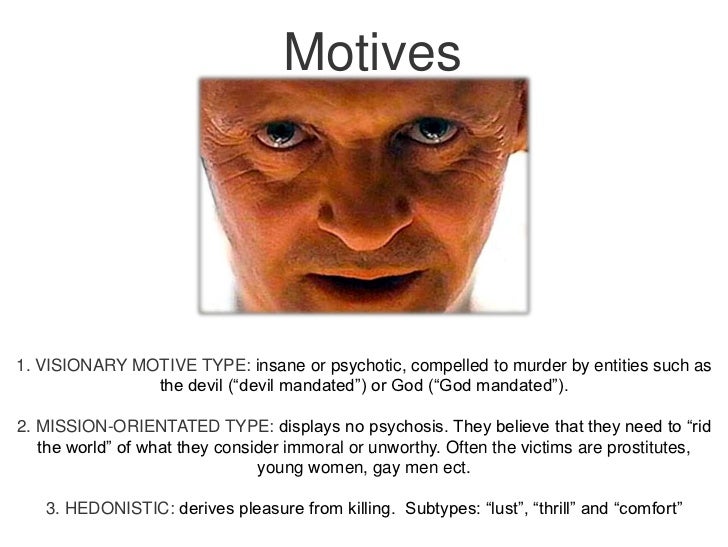Andrew Cunanan is given as an example of spree killing, while Charles Whitman is mentioned in connection with mass murder, and Jeffrey Dahmer with serial killing. These killers can also be further divided into visionary, mission-oriented, hedonistic, control-oriented or predatory (Simons p. The visionary killer hears voices telling him to kill (Simons p. The mission-oriented killer kills to eradicate an unwanted group of people (Simons p. Jun 30, 2016 - Mission-oriented serial killers, on the other hand, are not typically considered. Hitmen, for example, are sometimes considered comfort killers. Jan 1, 2000 - Mission Serial KillersTypes of Serial Killers. Types of serial killer. Organized and disorganized types. The FBI has roughly categorized serial. Gary Ridgway aka the Green River Killer was a Mission Oriented serial killer. He killed prostitutes because they were “unclean.” However, like most serial killers, he wasn’t entirely mission oriented. He raped the prostitutes before killing them, which isn’t uncommon with mission oriented serial killers.
Examples Of Visionary Serial Killers

The FBI estimates that there is anywhere between 25-50 active serial killers in the United States at any given time. It’s enough to make you wonder who they might be. Perhaps someone you bumped into on the street? Maybe a neighbor, a coworker or even family member – wouldn’t you like to know the tell-tale signs so you could avoid them at all costs?
While not all serial killers possess the same traits, have similar backgrounds, lifestyles or motives, there are several common denominators:
- Mental Illness/Psychopathy
- Victims of emotional, physical or sexual abuse
- Fetishism, partialism or necrophilia
- Fascination with fire setting
- Sadistic childhood activity like torturing animals
Just note, however, that having one of these traits doesn’t inevitably necessitate you’re a serial murderer, but you might want to consider seeking professional help. There is no infallible equation or formula for making a serial killer, but we have a rough idea of how they tick.
Based on motivations for killing, there are four basic types: visionary, mission-oriented, hedonistic and power/control seekers. There can be overlap, of course, depending on the killer.
The visionary generally suffers from a severe mental disorder and has lost touch with reality. They have delusions and hallucinations that compel them to murder. Sometimes they believe they were only doing what God or the Devil told them to do. The “Son of Sam” is a classic example of a visionary demon-mandated serial killer. He believed a demon spoke through his neighbor’s dog and ordered him to kill.
Examples Of Mission Oriented Serial Killers Examples

Mission-oriented serial killers, on the other hand, are not typically considered psychotic. They target people they deem undesirable and feel it’s their justifiable duty to eliminate them. With that said, victims are usually individuals from different religions and ethnic or racial groups. However, mission-oriented serial killers have also been known to murder based on sexual orientation and occupation; homosexuals and prostitutes have been targeted by this type of killer.
A hedonistic serial killer is the type you’d expect to see in a psychological thriller or horror movie. They take pleasure in killing and are capable of doing really heinous things to their victims. There are three subcategories of this type killer: thrill, lust and comfort killers.
Thrill killers get an adrenaline rush from inducing fear and pain. They live for the hunt and kill and many strive to commit the perfect murder, meaning they are able to go without killing for long periods of time and tend to refine their methods. For lust killers, fantasy is the key factor in their killings, and they get a rise out of torturing and mutilating their victims. The comfort killer murders for material gain and often has previous convictions for theft, fraud,embezzlement or other related crimes. Hitmen, for example, are sometimes considered comfort killers.
The primary motive for a power/control-oriented serial killer is self-explanatory. To overcome feelings of powerlessness or inadequacy, such killers murder to exert power and dominance over their victims. While this type often also sexuallyabuses their victims, it is not motivated by lust. Often, power/control-oriented serial killers were victims of sexual abuse themselves.
Despite popular belief that serial killers have an above average IQ, studies actually suggest, minus a few exceptions, that serial killers tend to have an average or low-average IQ. Out of a sample size of 202 individuals, 89 was their median IQ. Still, a low IQ is little comfort to anyone who might cross their paths.
As for what makes a serial killer, it’s hard to say. There are theories suggesting that damage to the frontal lobe of the brain, the part responsible for planning, motivation and decision-making, may be a trigger for murderous tendencies. Chromosomal abnormalities and mental illness may be another possibility.
However, the most common denominator found in serial killers relates to childhood development and trauma. Many came from broken homes caused by divorce, separation, a lack of discipline or an absent parent. A number of them were victims of physical, sexual and/or emotional abuse and neglect. Without support from others and positive relationships,a child is unlikely to recover from trauma in a positive way, but thankfully, most people who’ve experienced childhood trauma do not grow up to be serial killers.
If there is an “X” factor in the making of a serial killer, we don’t know it yet. They could be anybody...